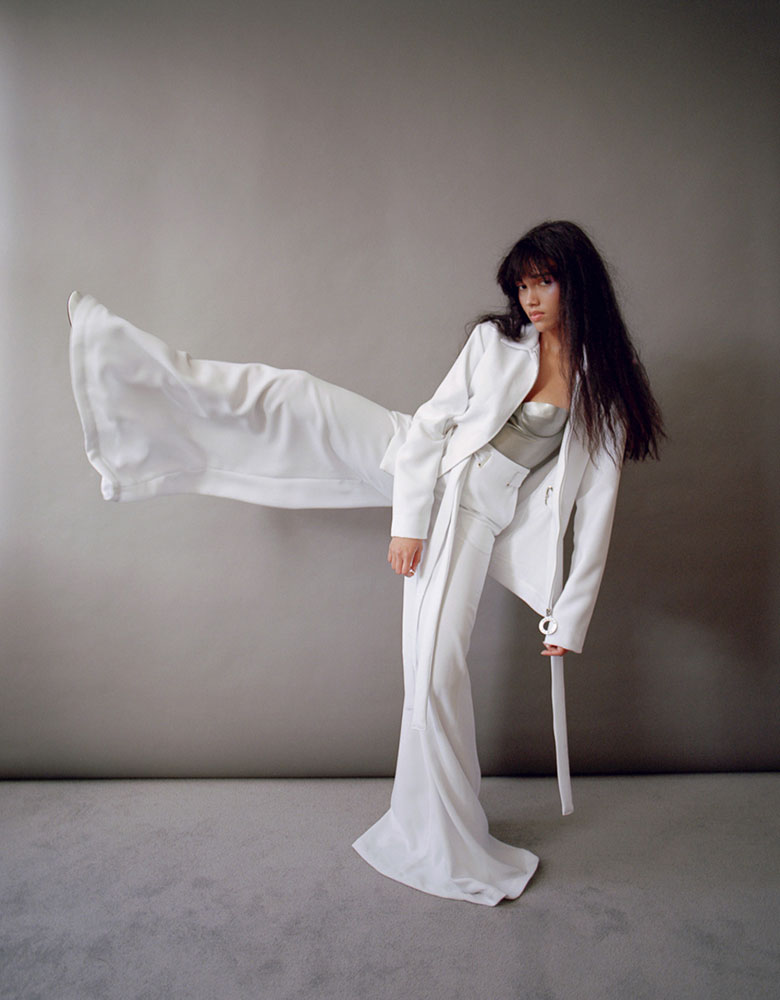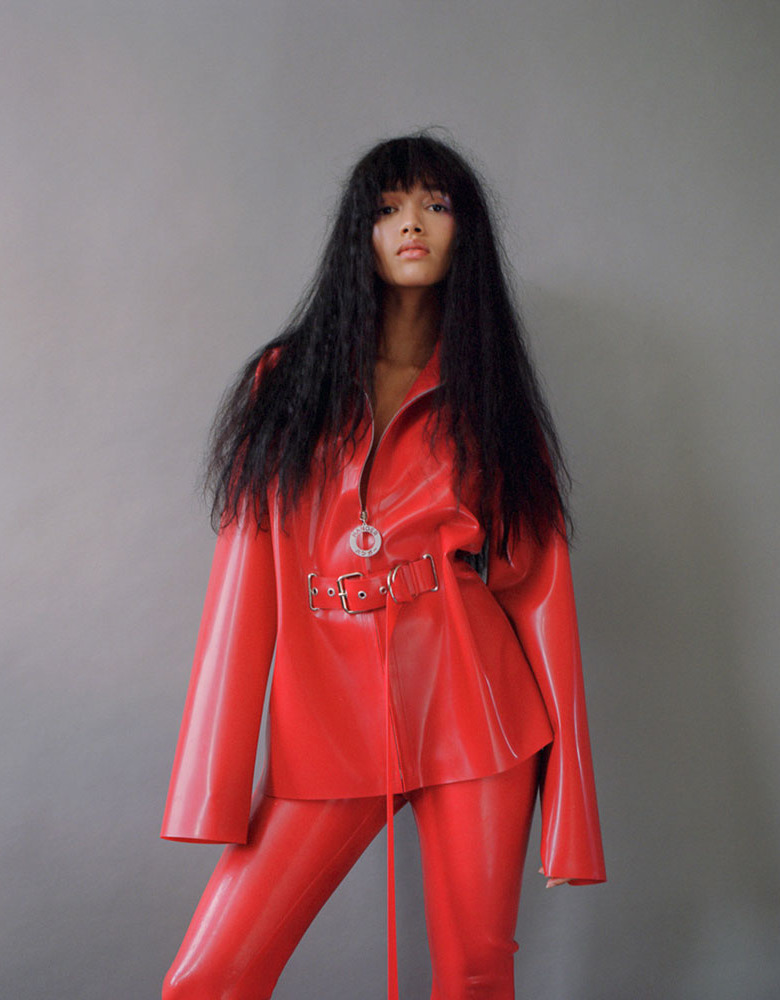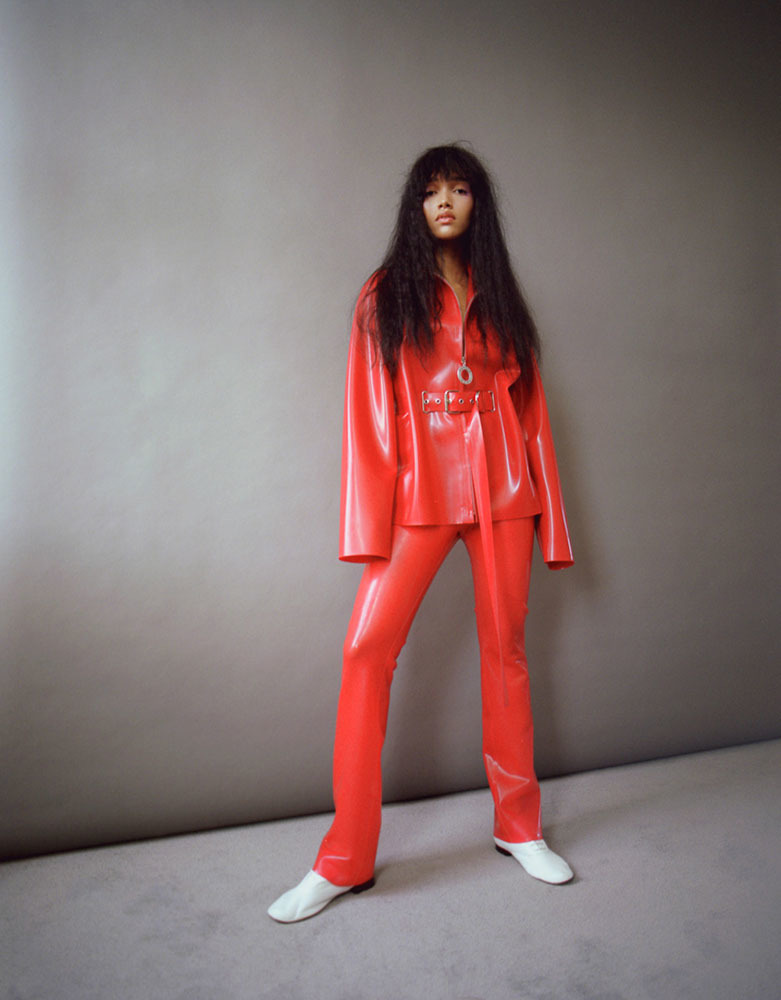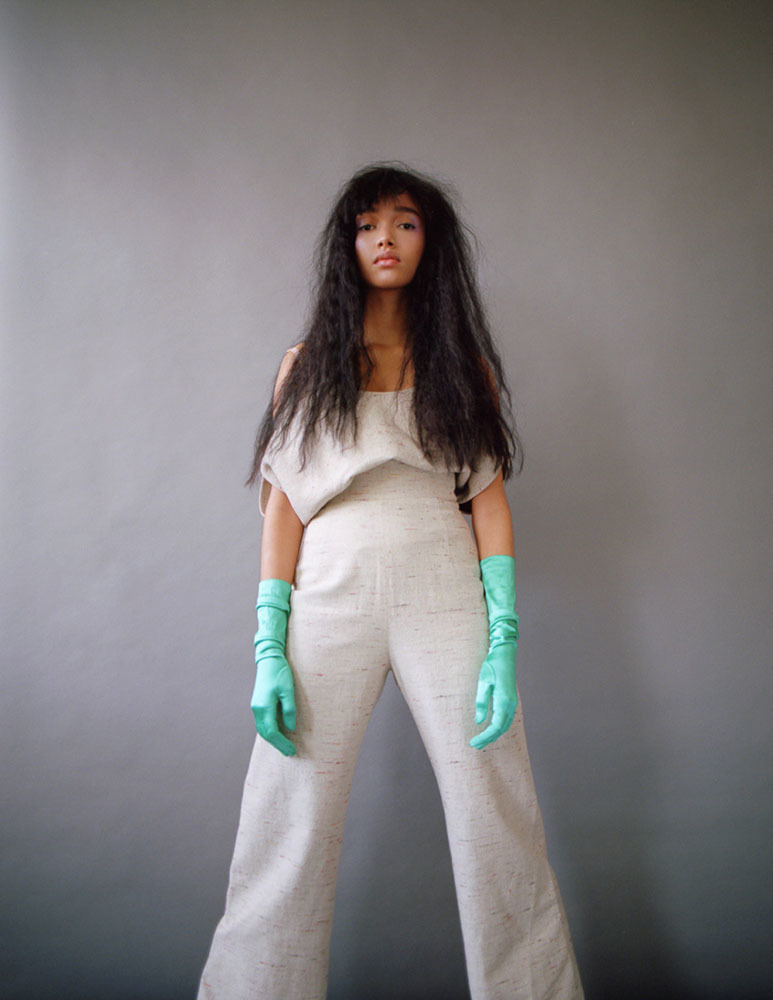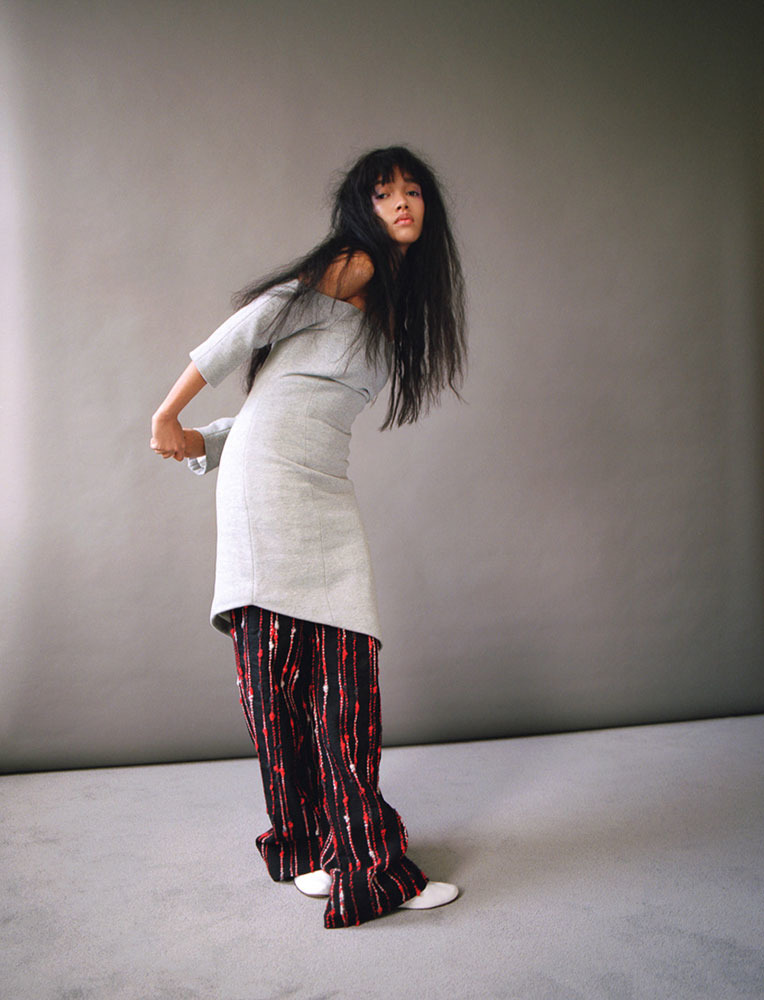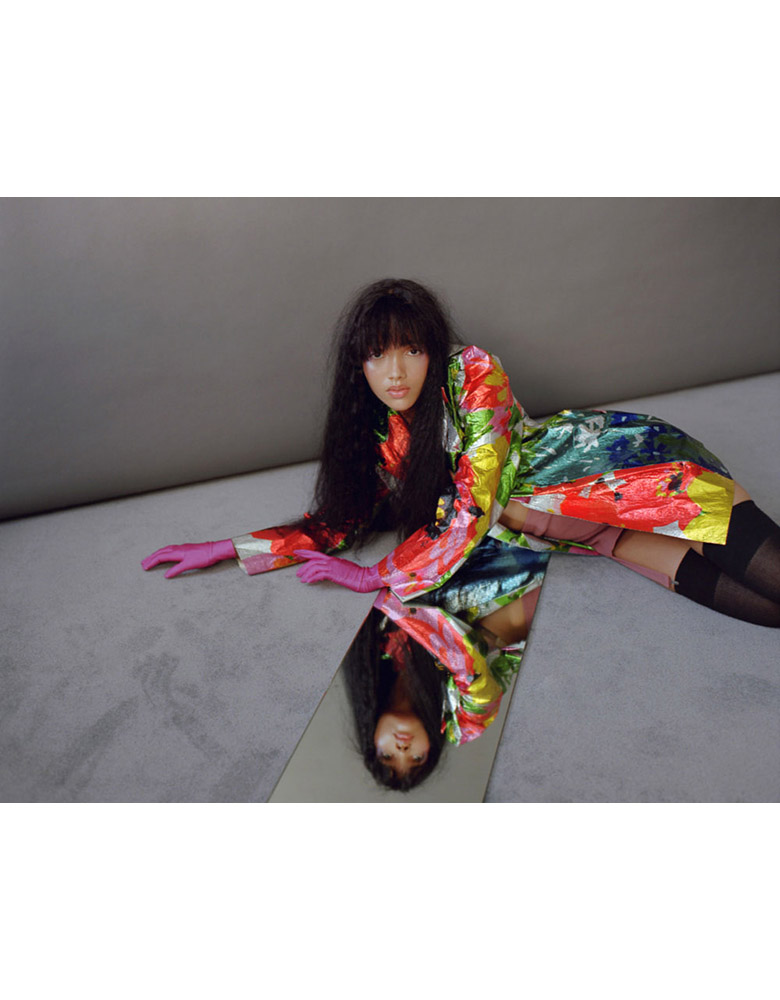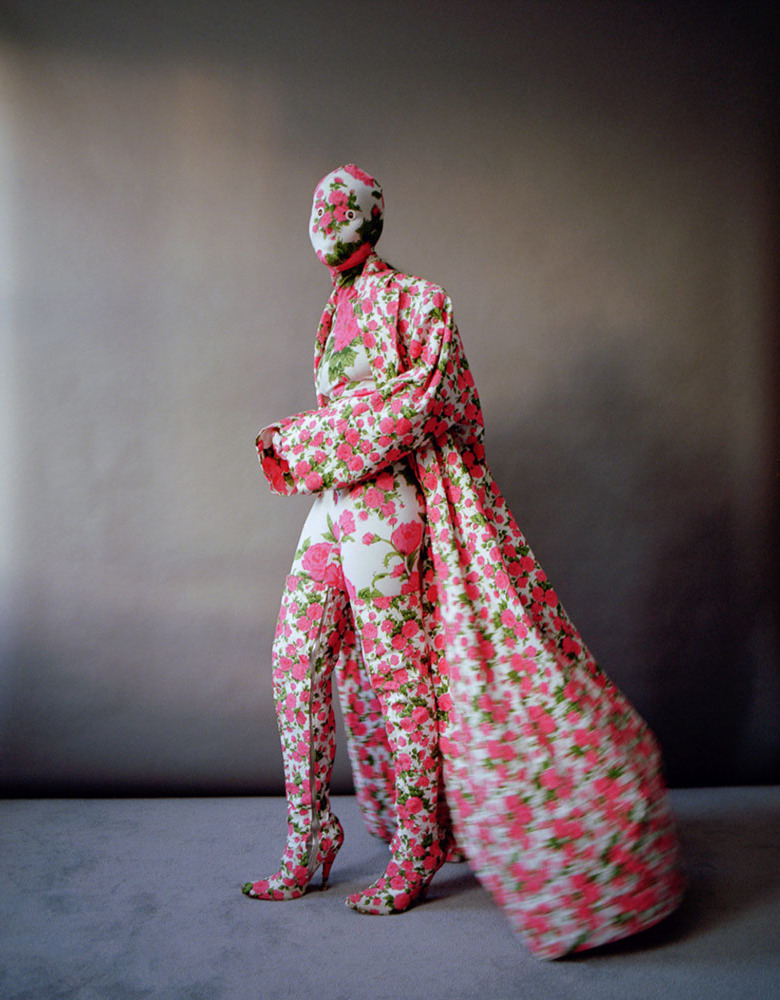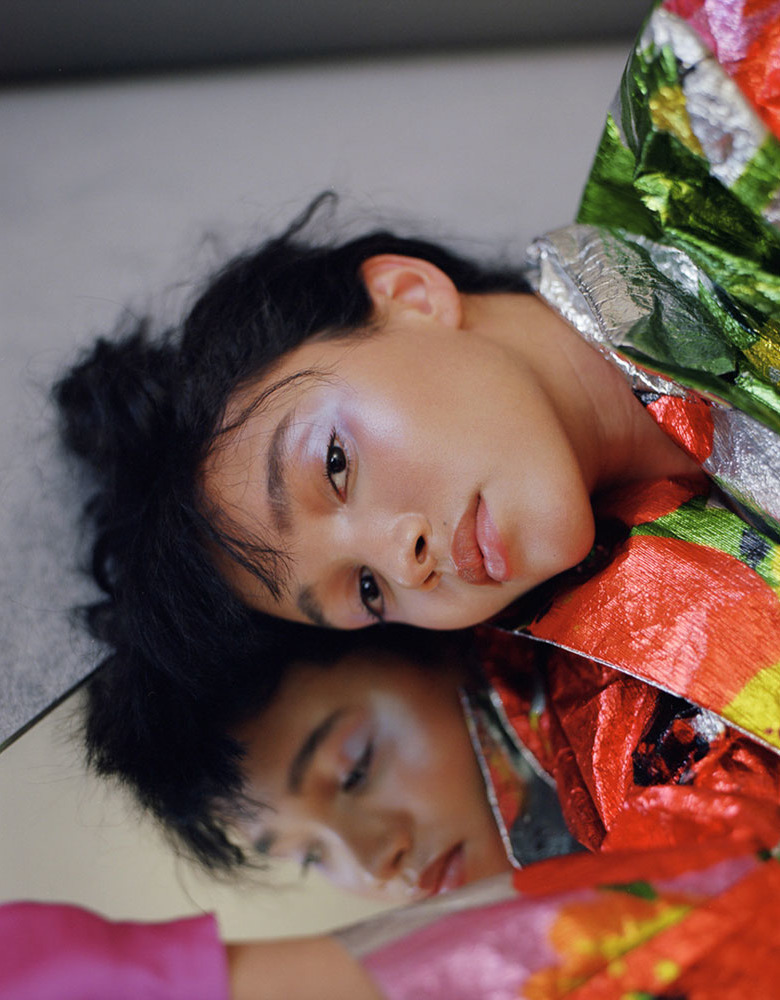The New Sustainables
Sustainability, a movement which offers progression and hope to the fashion system, has long been an ethos associated with the grande dame of punk, Vivienne Westwood, since her pioneering days in the 1970s. In 2017, she is no longer alone in her endeavours to reshape the industry, with upcoming innovative designers championing ethical approaches – from the fabrics and materials right through to the production.
Conscious of their carbon footprints but never compromising on style, sass or the avant-garde through attitude and conceptual silhouettes, this new breed of eco-friendly designers are truly sending waves through the industry and inspiring a new school of thought.
For our fashion issue, which is exploring and interpreting the theme of performance, we spotlight four London-based trailblazers who are carving out their names in the industry. We begin with non-conformist and founder of Hanger Inc Claire Yurika Davis, who masters a sci-fi Japanese-inspired aesthetic working chiefly in latex. Martine Jarlgaard whose designs are comprised of dressy nostalgia and understated decadence is up next. Recent CSM grad Richard Quinn, who is defining his own genre of ‘crack couture’ follows, and Czech designer Martina Spetlova renowned for her mashup of structured and striking sports luxe-wear ties it all up.
Hanger Inc.
Provocative, contemporarily feminine and empowering; there is something both poetic and sensual about Hanger Inc’s designs, from the silver hardware that bonds thick latex on chokers to the popper closures that adorn the wide silhouette of a long skirt.
The brainchild of Claire Yurika Davis – the first winner of ASOS’ ‘Fashion Discovery’ competition – since 2013 the young designer has been channelling her forward-thinking vision to create strong, graphic silhouettes which nod to a sci-fi aesthetic. Through seductive transparent latex and rubbery black wet looks she creates incredibly sensual yet tough visuals – think a business pant suit styled with a latex bra.
While working seasonless with her small mindful team and, ironically, alongside a latex allergy, Claire found five minutes to chat about her penchant for Japanese culture, the obstacles she’s overcome as an eco-friendly designer, and the schemes she’d love to see put in place for future budding sustainable designers.
Tell me a bit about how you started out?
After University, I tried to take the normal route and get a job in the industry, but no one would hire me! I’d always wanted to start my own brand so I thought that it was as good a time as any because I had nothing to lose. I ended up getting a lot of help from The Prince’s Trust as well as East London Small Business Centre and slowly started to build HANGER. I had no idea what I was doing but I do like a challenge, and I had a ton of support from the people around me. I suppose it’s just snowballed from there!
Your heritage is both British and Japanese – in what ways does the brand explore your dual-identity?
Growing up in London, and with my mother being Japanese, Japanese culture has always been something I am inherently a part of, as well as something which is almost a myth to me; maybe this is why I explore it so much creatively as a way to connect to it. Japanese cinema and subcultures are what really inspire me the most. I tend to draw my inspiration from Japanese cinema – anything from an old Kurosawa piece to a film like Sayonara Speed Tribes, which is what I look at for my last collection. The Bosozoku biker girl gangs are who I have been looking at a lot recently; I love the attitude they convey – a hybrid of femininity and empowerment. My interpretation isn’t ever very literal though as I usually break it up with some tailored pieces and London street style references. It’s easy wanting to simply replicate the same shapes over and over but I hate nostalgia and so I try to pull the mood and translate it onto a timeless cut.
Being ethical is at the core of your brand, which isn’t always an easy option for designers when starting out. Tell me why it was so important to work ethically and seasonless and about any challenges you have overcome?
Most of us are equipped enough to produce garments that don’t harm the planet or other people, but there still aren’t enough UK factories around which is a bummer from a sustainability and quality control point of view. I’m hoping that this will change over the next few years. I recently decided to drop seasonal references when I thought about how irrelevant it seems when you look at the way people shop and the climate we live in. It’s important for designers and brands to take responsibility for impacting the world and its workers positively instead of caring so much about constantly wanting new goods and a lack of appreciation. I know it sounds counter productive for someone whose business is selling clothes to say, “But people need to buy less and think about longevity!” I think it’s very much a generational thing which will hopefully swing back in the other direction soon.
As we don’t want to be another unaffordable luxury line, I’d say our main challenge is being able to source fabrics that are eco-friendly but in line with the price point we are trying to keep. I would imagine with sustainability gaining popularity, these problems would decrease over time.
I’ve know you’re extremely allergic to latex, what draws you to working with it and how do you get round in handling your garments?
Aside from it looking sexy as fuck and being a natural fibre, latex is extremely durable and versatile – which pretty much sums up why I love it. The downside is that through working with it is how I actually developed my allergy. Anyway, I won’t be defeated as I have antihistamines on my mind… and a cute mouth mask.
You were the first winner of ASOS’ first Fashion Discover competition. How will you be developing the brand with the prize money?
I’d love to incorporate the eco-friendly aspect further and, with ASOS selling our next few collections, scale up production volume but remain as accessible as possible. I’m planning to spend more time visiting factories, sourcing materials and generally making the most of having a relationship with ASOS. As I’m also still a sucker for physical stores, I’d love to be stocked in more places – especially in Japan.
What are your thoughts on the importance of support and funding for sustainable designers? Do you think that there is adequate support available to young designers at the moment?
There definitely isn’t enough support for sustainable designers. It’s slowly gaining more traction but funding for young designers on the whole is fairly exclusive, and in my opinion is slightly more geared to making your brand a name in the industry instead of helping you to create a functioning business. However, I do think London is great for having things such as NEWGEN and Fashion East available for young designers but it would be even better to see an award scheme that pushes sustainability alongside high fashion.
What do you predict for the future of sustainability? Do you think more designers will begin to adopt an ethical approach?
Lots of companies are already tapping into sustainability but it often consists of checking a box. I think more and more people care about what brands stand for, aside from the product they’ve got to offer. I’d imagine this would encourage more designers to actually adopt an eco-friendly and sustainable practice. In time it should become easier and easier, and so to not incorporate an aspect of sustainability would be as scandalous as not having soya milk or something?!
Martine Jarlgaard
Drawn towards codes of garments and cultures, Martine Jarlgaard works with balancing contradicting expressions in her designs to create a minimalist, abstract aesthetic she calls “understated decadence with a relaxed, futuristic language of simplicity”. She pools her inspiration from asking questions, the future and thinking sculpturally to create shapes which explore femininity and dressy nostalgia.
On the surface, Martine’s garments evoke a sense of simplicity. Her SS17 collection consists of a limited palette with clean, crisp whites, soft greys and the muted quietness of the colour black. However, the silhouettes and cuts are rather unconventional. An off-shoulder top is not simply just so; dresses with an off-shoulder neckline have half-moon dips beneath the collar bones and full length skirts comprise of two neat, clean cuts mid-thigh. It’s the subtleties in Martine’s designs that are small innovations to timeless pieces.
And Martine is an expert in timelessness. As a sustainable designer with ethical practices, her garments are created to last the test of time, as well as embodying the appearance of modern elegance. Below, we catch up with the designer to learn about her time at Vivienne Westwood, her thoughts on the culture of instant gratification and the time and effort that goes into working sustainable.
Tell me why sustainability is so important to you and when did it become part of your social consciousness?
Ethics and sustainability are important to me as I love nature and I care about the world we live in. I think it’s pretty basic. Sustainability and responsibility in business as in any aspect of life shouldn’t be considered remarkable. It should be a naturally integrated part of everything we do.
Thinking this way has always been part of me. It’s how I was raised and who I am. Perhaps growing up by the sea, having a horse, dogs and cats as well as strong grandmothers who had experienced second world war makes you this way. I don’t know. But I often wonder what you would think about nature (and the preservation of it) if you have never been close to it. I wonder if I would still have had the same connection to nature if I’d grown up on the 70th floor of an apartment block somewhere in a city of millions.
What are your thoughts on the pace of fashion?
The escalation of pace in fashion, a highly-saturated market, slowing growth as well as the relatively new ‘see now, buy now’ model to meet consumers’ demand for instant gratification have all created a highly unstable construct where creativity, quality and diversity are suffering.
I believe that step by step, brands will give greater importance to becoming increasingly autonomous of the traditional fashion system. Technology has made it possible for companies to reach a wider audience and to interact in new ways.
You’ve previously worked at Vivienne Westwood. What did you learn from your experiences there? And did her ethical ethos influence you in any way?
Working for Vivienne Westwood was my first job after graduating from the Royal Danish Academy of Fine Arts in Copenhagen. I travelled with Vivienne and the team for the world-touring, retrospective V&A exhibition, designed the Red Label, worked a lot in Italy, did fabric sourcing meetings, fittings, presentations in Paris, styling for London Fashion Week shows, etc. I got a profound understanding of the dynamics of an international luxury brand and I was fortunate enough to work across different departments which gave me insight in the business as a whole. Having been trusted with great responsibility meant that I was working all the time but had a key role which gave me an incredible training and an invaluable experience.
When I worked with Vivienne she was very preoccupied with her manifesto. As much as I think it’s crucial to engage to impact things for the better, I cannot say that it was her ethos which influenced me as ethics have always been an essential part of me so it wasn’t something new to me.
Sustainability is very much part of the Scandinavian everyday conversation and culture whereas I feel that the UK is, in some aspects, lacking behind. The air pollution here is scary and a big step backwards. Where is the renewable energy? Where are the solar panels?
What are some of the challenges you’ve faced in creating a sustainable brand?
Time. It takes much more time and effort and is far more difficult than working in the conventional way. Purely from a business perspective being sustainable is a disadvantage as processes are far more complicated and materials more expensive.
Sometimes I think about ‘Dogme’ films when I think about the challenges sustainable fashion is facing. In 1995, two film directors made the ‘Dogme 95 Manifesto’ which was a list of filmmaking rules excluding the use of elaborate special effects and technology. These rules were restrictive and could easily be considered disadvantageous. Nonetheless ‘Dogme’ created a movement of highly celebrated films through restrictive rules which pushed creativity and made a strong statement.
In a somewhat similar manner, sustainable fashion must rebrand itself and make disadvantages into advantages.
What do you think of the available support there is for young designers? Do you think there’s enough?
With Martine Jarlgaard London I’ve worked with Centre for Sustainable Fashion, supported by Kering Group and the European Development Fund, for the advancement of ethical and sustainable fashion. So, yes, there’s some support but I would say it could be better as supporting businesses with an ethical and sustainable approach should be a priority. It’s crucial to lead the way and to help make it an advantage rather than a disadvantage to care.
You’ve played with the idea of mixed reality before where models were presented as three-dimensional holograms back in September 2016. Could you walk me through the thought process behind this and how you implemented your ideas?
The idea of using mixed reality to show the collection came from a vision of changing and democratising fashion. Through the cross-disciplinary collaboration between Fashion Innovation Agency, DoubleMe and Martine Jarlgaard London we wanted to encourage curiosity and exploration rather than passive observation.
The collection was recorded in a blue screen space with cameras surrounding the model. The digital material was then translated into three-dimensional holograms which you see when wearing the HoloLens.
This way of experiencing the collection virtually and three-dimensionally is optimal as you see the collection pieces as complete, life-size sculptures as you navigate around the models; up close or from afar, as you please.
Being able to replay the show again and again is hugely advantageous as it can be shown anywhere and repeatedly without being reliant on extensive show production.
Is the use of technology and steering away from the traditional runway format, for you, linked to sustainability?
Absolutely. Stepping away from the traditional runway concept reflects the vision of wanting to create another, visionary and inclusive version of fashion which pushes innovation and which takes environmental and ethical challenges seriously.
Technology and science can help us build a more intelligent future through e.g. renewable energy, new materials, new production methods such as 3D printing which allows for more independent and local production as well as technology can assist in creating easily accessible supply chain transparency, optimisation of communication, learning and experiencing through augmented and virtual reality.
The future might be a lot more immaterial than we imagine. Instead of physical garments a large part of fashion could instead be virtual experiences in which interacting with and wearing virtual garments, recording, photographing and posting these could be what matters. The future could be a place where our need for consumption and newness is mostly acted out virtually and where we have found a holistic lifestyle in which material fashion exists but where the consumption has reached a sustainable level.
What do you see for the future of sustainability?
The fashion I envision isn’t fashion as we know it. I believe that we will see a more interactive, exploratory future in which the consumers are drawn towards experiences, ethics, authenticity and vision which goes beyond mere aesthetics.
What advice would you give to fashion students and graduates now?
Re-think everything.
Richard Quinn
Large couture dresses – reminiscent of Dior’s New Look in the 40s and 50s – are given a modern reimagining by being spliced in half with contrasting prints of florals and houndstooth. Yet what evokes Quinn’s dark and unsettling atmosphere is his ability to morph the models into the fabrics themselves. There’s a surreal sense of anonymity in the way models are masked and entirely covered in fabric. There aren’t any gaping cuts revealing human skin, thus resulting in the models appearing as though they’re otherworldly creatures completely embodying Quinn’s art as their alien skin.
Already, Quinn is a trailblazer in the industry with an independent spirit of creating ethical prints. The young designer also recently won H&M’s coveted Design Award and is giving back to the community by setting up a print studio in Peckham and making prints at an affordable price.
Here we get the low-down from the burgeoning talent about the surreal, find out when working sustainable became imperative and what it’s like working with H&M on creating a more ethical industry.
Can you start off by telling me a bit about your background? Did growing up in south east London inspire you to pursue fashion?
I grew up in Eltham in south east London. It was a fantastic childhood; our house was surrounded by parkland and my best friend lived on the next road so it was great especially during the summer! I am one of five children and my brother and sisters are very academic but I have always been into creative things. I loved to paint and try and make things me and my sister would see on Art Attack. I really began to focus on art and design during school and it seemed to be a natural progression from there.
You’ve been dubbed as the creator of ‘cracked couture’. How would you describe your aesthetic?
I want to create collections that are part of my world. I always find it fascinating when a designer can evolve each season pushing new ideas, shapes, colour and prints but still retain their signature. I think my aesthetic is unapologetic, bold and unafraid.
Where do you draw your inspiration from?
I always find Tim Walker’s photography such a source of inspiration. Not to draw directly from the photos but to really study how he creates an atmosphere with such conviction. The space and characters change with the sequences but you can tell it is his photograph a mile off. I always find inspiration in my personal mood. It affects what music and colours I’m drawn to. Also, obscure objects found rummaging through vintage stores or boot fairs are really great.
You’ve also said before that music always inspires the collection. Which musicians are you listening to at the moment?
In the studio we are always listening to The Cure, The Smiths, Gatecrasher and Pure Garage Platinum.
There’s a surreal element to your work in that the women become the textile so they appear as something other than human. Are there any surreal artists or films that you’ve been inspired by?
I was introduced to Paul Harris, a relatively undocumented artist from the 1960s by one of my tutors, Fleet Bigwood on the MA at Saint Martins. The fabrics I was researching and developing, Paul used in his sculptures in such a modern way. There were such parallels in what I was trying to achieve that it really evolved from there.
Have you always been concerned about sustainability?
I was quite naïve in regards to sustainability – uneducated, in fact. I was very blasé about the whole subject. It was when I was awarded the Stella McCartney Scholarship to study MA Fashion at CSM I was given in-depth information on how the effects of the fashion industry can really impact the environment. It was a real education showing me that fashion can be forward thinking and cutting edge, but sustainable. In most cases, the idea of restricting your means and selection of fabrics can make you become more resourceful and intelligent in your design.
Why do you think it’s important?
The environment and world we live in needs to be maintained not only for this but the next generation. The fashion industry can have immediate and detrimental effects that can be really devastating. If this can be prevented, I don’t see any excuse for it.
When did you start incorporating eco-friendly elements into your designs and in what ways are your designs ethical?
It was when I was really thinking on the MA how to make my collection as I wanted it without compromise using ethical methods. The collection was screen printed by myself in London using non-toxic pigments and mediums. The fabrics were all natural and had no animal bi products . I also developed a patent solution that created the effect of patent leather with non-toxic methods. This was used on the trench coat and the patent boots.
What challenges have you faced in being an ethical designer?
I think every problem will always have a solution. There are lots of creative ways around a problem. I also specialize in textiles so it’s nice to challenge myself to create fresh textiles that don’t have to be the easiest option.
I’ve read that you run your own print studio in Peckham. Could you explain how the idea for this started and how you went about setting it up?
I wanted my label to be printed and made in London. A real sense of a handmade, limited run of pieces per season. The idea that if you buy from my label you will have a piece actually printed and cut in my studio. It also doubles as an open access studio for other designers and artists. We also offer a design, print and digital print service. The studio will launch in March 2017.
You won the H&M Design Award not long ago. While H&M have an ethical ethos, they’re also a fast fashion outlet, which is quite different from your couture designs. Will we be seeing some of your designs in H&M? And if so, how will you be approaching the task of developing your pieces for a larger and faster market?
The great thing about the H&M Award is that they are embracing all types of fashion and creativity, really giving a voice to people starting out. In a way, they are looking for something different to what is already out there. The collection, based from the winning MA collection pieces, will be launching in 2017 so it’s a very exciting time. H&M are also passionate about bringing change to the fashion industry with their conscious collections that are ethically sourced and made. I have worked with the conscious team on my collection and it’s incredible to learn so much from them.
What are your thoughts on the pace of fashion?
It can be as fast as you want it to be. I will be launching my first debut collection, the first since my MA, in September 2017. I will continue to show twice a year. I think it’s more exciting when you allow time for ideas to evolve and you actually have something to say. Who needs another meaningless resort collection? I find it more exciting to collaborate on projects or small runs of pieces that have something to say.
Where do you see sustainability going in fashion?
I don’t think there will be a fashion industry without being sustainable. How can you be a modern brand if your process is in the dark ages? To me, that’s not sustainable or relevant in 2017 or the future.
What advice would you give to a new designer who’s thinking of creating a sustainable brand?
I think every young designer should be aware of the world around them and the impact they can have for positive change.
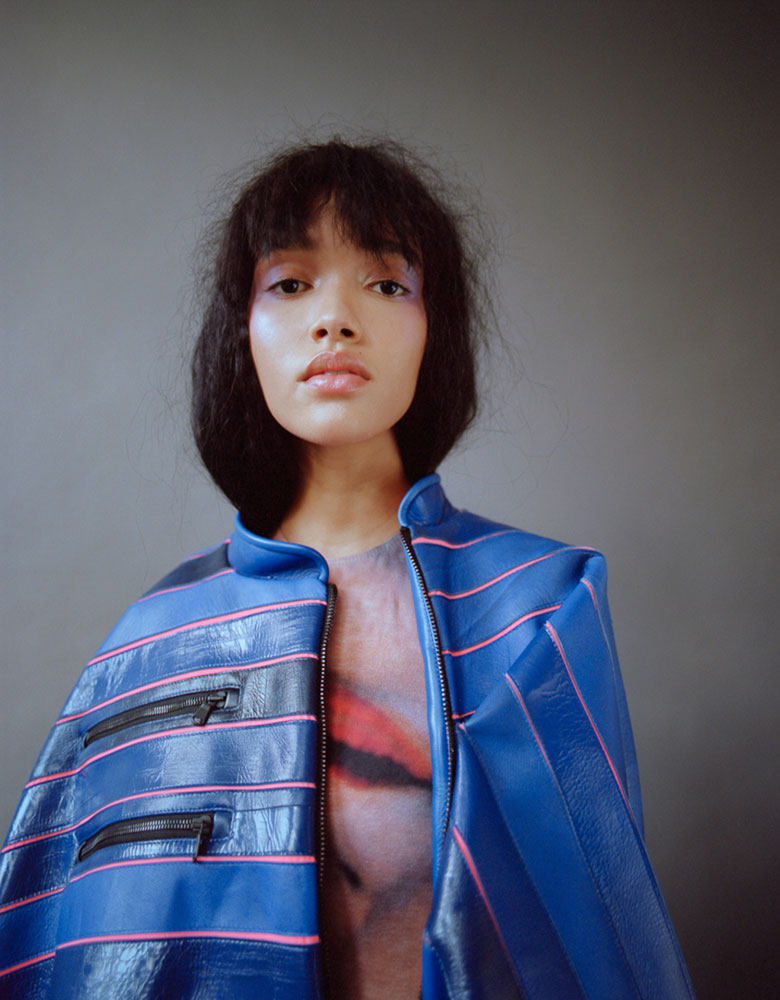
Martina Spetlova
While some may think that science and fashion exist in separate spheres, Martina Spetlova is a designer who works to weave the two worlds together with her carefully handcrafted leather and silk pieces.
Hailing from Prague, the designer trained in chemistry in her motherland before making the plunge to London to enrol at CSM. Fast forward to 2017 and the visionary has worked alongside Jeremy Scott while setting up a women’s artisan centre in Pakistan, John Galliano and began her eponymous label.
Her modern aesthetic can be described as mashup of structured and striking sports luxe-wear, with the majority of her pieces constructed from woven textiles and made complete via airbrushed techniques to finish leather hides.
And yet, while the use of leather may not seem in line with sustainable ethics within fashion, Spetlova has made this possible through her collaboration with ECCO – one the most environmentally friendly tanneries in the world. The blend of science with fashion and ethics is a unique mix; one that’s very modern and fashion-forward, much like her designs. And it acts as a signifier of how Spetlova is an artist who dares to be different.
Here we delve into the designers inspirations, how chemistry plays into her design process and her thoughts on the pace of fashion.
Tell me a little bit about the setup of your brand?
I am based in London and have a very small team – you could say it is a one woman show. I oversee everything and make sure that each stage of my production reflects the best quality to ensure fine finishings and a timeless pieces for the assertive and sophisticated woman.
Explain to me how chemistry plays into your designs?
I see subtle similarities between chemistry and fashion in the way I construct my textiles through experimentation with colours and textures. Take the way the designer mixes her leathers and silks, weaving and pleating them together. My alchemy echoes the blending and mixing of chemicals in order to activate a prescribed reaction within the laboratory.
In what ways is your brand eco-friendly? And what challenges have you faced along the road?
I work mainly in leather, which unfortunately generates lots of wastage in the production process. A lot of luxury brands insist on using the softest middle of a skin hide and discarding the rest for luxury leather goods such as gloves etc. it is something that has always bothered me, so I have been working towards zero waste in my production by using specialist CNC machines with new pattern cutting technology that can cut the individual leather panels of my garments in the most economical way. The very small off-cuts that we still generate are then passed on to fashion students or used for small products. Additionally, I collaborate with ECCO tannery from Holland that have very sustainable policies, very high quality leather hides and work directly with organic farmers and certified slaughterhouses.
I am working hard at creating a very sustainable supply chain and although it is very challenging and a slow process and needs lots of commitment, I do believe it is the only way now to create meaningful, special and long lasting pieces that customer appreciate enough to buy and look after.
Where do you draw your inspiration from?
I look to modern art for inspiration. In past collections I have been extremely inspired by an incredible artist, Justin Mortimer, who used blurred black and white photography injected with bold mists of bright colours. I have used similar effects in airbrushing leather hides. For the current SS17 season, I have used the work of Canadian artist David Altmejd, whose sculptures I have seen at The Fine Art Museum in Brussels, as the main source of inspiration.
What are your thoughts on the pace of fashion?
Fashion is fast, be it high street or luxury it is ever evolving. For young and emerging designers it can be quite a challenge competing against the big brands that produce pre collections, main and so on. Being sustainable is the best form of slow fashion, and ensures that as little waste as possible goes in the process of production.
Finally, where do you think sustainability is going in fashion?
I think we have come a long way and that things are moving in the right direction, which is fantastic, but for many years there has been a lot of empty promises and PR spin. There are now more genuinely sustainable focused brands and more suppliers that offer sustainable fabrics. Larger and older companies are modernising and transforming and emphasising sustainability, which is great!
Photographer: Laura McCluskey
Stylist: Shirley Amartey
Model: Cassey Chanel of Wilhelmina
Make up: Gabriella Floyd
Hair: Takuya Uchiyama

